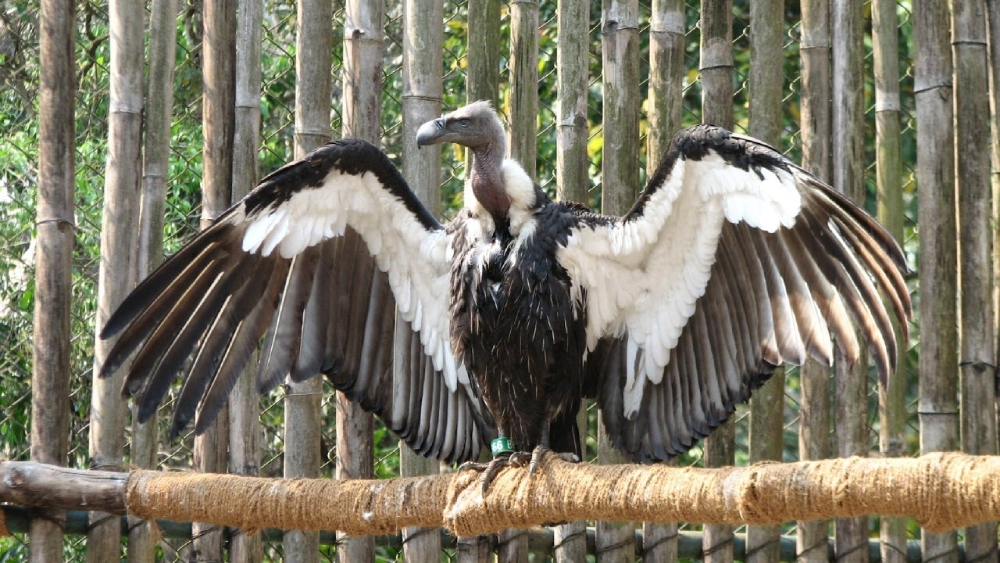In the sprawling tapestry of nature’s diversity, every creature plays a vital role, contributing to the delicate balance of ecosystems. Among these, the White-Rumped Vulture (Gyps bengalensis) stands as a majestic sentinel, patrolling the skies of South Asia. Yet, despite its imposing presence, this iconic bird of prey faces a daunting threat – the specter of extinction.
A Glimpse into the Skies
The White-Rumped Vulture, with its impressive wingspan of up to 9 feet and distinctive white-rumped plumage, commands attention wherever it soars. Found predominantly in the Indian subcontinent, these raptors frequent a variety of habitats, from grasslands and savannas to urban areas. Their aerial prowess and keen eyesight make them efficient scavengers, primarily feeding on carrion.
The Ecological Significance
Within the intricate web of ecological relationships, vultures hold a crucial position as nature’s cleanup crew. Their scavenging behavior helps prevent the spread of diseases by swiftly disposing of carcasses, thus maintaining the overall health of ecosystems. In regions where the White-Rumped Vulture thrives, its presence is indicative of a balanced environment.
The Plight of the White-Rumped Vulture
However, despite its ecological significance and cultural reverence in some regions, the White-Rumped Vulture has been thrust into a battle for survival. The primary culprit behind its decline is the widespread use of diclofenac, a veterinary drug administered to livestock. While harmless to cattle, diclofenac proves lethal to vultures when they consume the carcasses of treated animals. This has resulted in a catastrophic population decline, with some estimates suggesting a staggering 99% decrease in numbers since the 1990s.
Conservation Efforts
Recognizing the urgent need to safeguard this imperiled species, conservationists and governmental agencies have rallied to implement various initiatives. One such endeavor involves the establishment of captive breeding programs aimed at bolstering dwindling populations. Institutions like the Bombay Natural History Society (BNHS) have been at the forefront of these efforts, successfully breeding White-Rumped Vultures in controlled environments.
Additionally, legislative measures banning the use of diclofenac in veterinary practices have been enacted across affected regions, signaling a pivotal step towards mitigating the threat posed by this harmful substance. Furthermore, community engagement and awareness campaigns play a vital role in fostering a culture of vulture conservation, emphasizing the importance of these birds in maintaining ecological equilibrium.
### Challenges on the Horizon
Despite these commendable efforts, the road to White-Rumped Vulture recovery is fraught with challenges. Habitat loss, electrocution from power lines, and secondary poisoning from other veterinary drugs continue to exert pressure on already vulnerable populations. Moreover, the slow reproductive rate of vultures, coupled with their long lifespan, compounds the difficulties associated with rebuilding their numbers.
Looking Towards a Brighter Future
While the plight of the White-Rumped Vulture remains dire, there are glimmers of hope illuminating the horizon. Through concerted conservation actions, coupled with international collaboration and public support, it is possible to steer this magnificent species away from the brink of extinction. Continued research into alternative veterinary drugs, coupled with habitat restoration initiatives, will be instrumental in securing a future where the skies remain graced by the elegant silhouette of the White-Rumped Vulture.
Conclusion
In the narrative of conservation, the White-Rumped Vulture emerges as both a symbol of resilience and a clarion call for action. Its fate hangs in the balance, poised between the shadows of extinction and the promise of redemption. As stewards of the natural world, it is incumbent upon us to ensure that this majestic sentinel continues to soar, a testament to the enduring power of collective conservation efforts. For in the preservation of the White-Rumped Vulture, we safeguard not only a species but the intricate tapestry of life itself.










